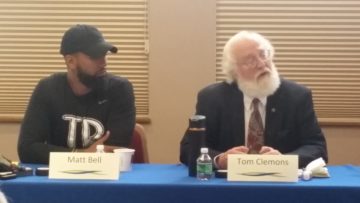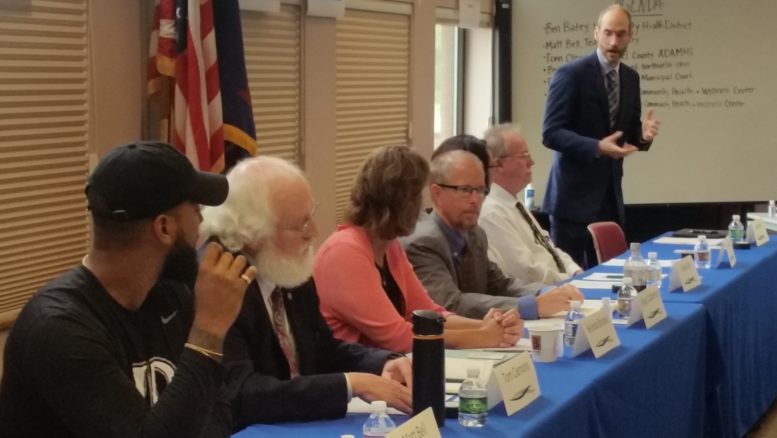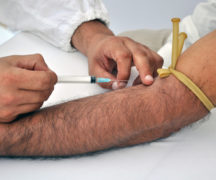By JAN LARSON McLAUGHLIN
BG Independent News
Matt Bell knew he had hit rock bottom when he called the police. “I had a gun in my mouth,” he said Thursday to the crowd of people gathered to hear about the opiate crisis and the steps being taken locally to stop it.
It had taken Bell several years to get to that point. He had led a charmed childhood, with a loving family, earning straight As in school and competing as a star athlete in three sports. Bell was so squeaky clean that he broke up with his first girlfriend because she smoked cigarettes.
Bell went to college on an athletic scholarship for baseball, and had three professional teams scouting him. But that all changed when he tore his rotator cuff and was prescribed 90 percocets. Ninety percent of the time, opiate addictions start with prescribed pain pills, he said.
He was hooked.
“The pills got too expensive, so I switched over to heroin,” Bell said. The dealer gave him his first hit of heroin for free – knowing Bell would be back.
Bell shared his story about opiates, along with health officials who are trying to find answers, a mom who nearly lost her daughter to opiates, and a court official who helped put together a program to help inmates avoid the drugs when they leave jail.
“Opiates, heroin specifically, is what brought me to my knees,” Bell said. He tried rehab many times, overdosed three times, and was arrested four times.
But Bell told a story of success – like many of those speaking Thursday at the opiate program at the Wood County Health District during National Health Center Week.
Now Bell leads the Team Recovery program, helping others live without opiates. “This is not an inner city problem. This is a community problem,” Bell said.
Ohio has the distinction of being top in the nation for opiate deaths, with 4,139 last year – or 11.3 people a day, Bell said. In Wood County, there were at least 16 deaths last year from opiate overdoses.

Matt Bell and Tom Clemons talk about opiate crisis.
“These are people, they’re not junkies,” Bell said.
This is an addiction – not a choice, he said. Once a person starts using opiates, it takes priority over everything else in their lives – eating, bathing or even caring for their children.
“We need to realize this is truly a disease,” he said.
Sometimes, the numbers and the stories seem overwhelming.
“Everybody I know, knows somebody who’s been affected by this,” Wood County Health Commissioner Ben Batey said.
“This is every day. This is every week. This is an ongoing issue we deal with,” State Senator Randy Gardner said.
But every speaker on the panel offered a message of hope. Yes, the average addict relapses seven times, but “here’s living hope,” Tom Clemons, executive director of the Wood County Alcohol Drug Addiction and Mental Health Services Board, said of Bell.
“It’s really easy to become addicted to opiates, but recovery is very difficult,” Clemons said.
The ADAMHS board has spent close to $800,000 a year on services combating the opiate crisis. And there are plans to expand services, including the opening of a women’s recovery residential center. The county already has one in operation for men.
There are also services for family members of addicts, including SOLACE of Northwest Ohio started by Luckey Mayor Belinda Brooks, whose daughter battled opiates for several years.
Her daughter, now 25, was first prescribed percocets after an ATV accident seven years ago. It wasn’t long till she was addicted. Brooks, who knew nothing about opiates, believed it couldn’t be that bad since it was a prescribed medication.
She soon saw how horrible it could be. Brooks learned that by hiding the addiction and helping her daughter clean up money problems, she was fueling her daughter’s addiction.
“It was three years of complete hell,” Brooks said. “Your lives change forever. You have to change your parenting.”
Her daughter’s rock bottom came when she was charged with nine felony counts in Toledo. Brooks cut ties with her daughter and took over raising her grandson.
She remembers the words she told her daughter that day. “I love you. But I’m done. Don’t ever call me again unless you’re in treatment.” Her daughter went to jail and they did not speak for six months. It’s now been 20 months since she has been clean.
But as a parent, Brooks knows relapse could be right around the corner. “I worry every day,” she said.
The positive news is that Wood and Lucas counties have great treatment resources, she said. But more must be done, including educating kids at earlier ages about addictions, and helping families caught up in the crisis.
“The destruction it causes is devastating,” resulting in many aging grandparents taking over care of their grandchildren.
To help families get over opiate abuse, Brooks heads up support groups called SOLACE in Perrysburg and Bowling Green.
Doug Cubberley, of Bowling Green Municipal Court, also talked about help for inmates at the county jail. A vivitrol program was started after the courts and probation departments realized that inmates being released from jail were dying because they started using opiates again and were at higher risks of overdosing.
Before being released, the inmates are given vivitrol shots that take away the craving for opiates, and they are entered into treatment programs.
According to Cubberley, 31 vivitrol shots have been administered so far, with 19 considered successful.
“We’re still measuring success one day at a time,” he said.
The vivitrol program works closely with the Wood County Health District. The health and wellness center also tries to connect recovering addicts with food, shelter, transportation and employment.
The county’s opiate task force also works on outreach, holding three town halls throughout the county, hosting prevention and awareness events, and aiding support groups for recovering addicts and their families, Cubberley said.





